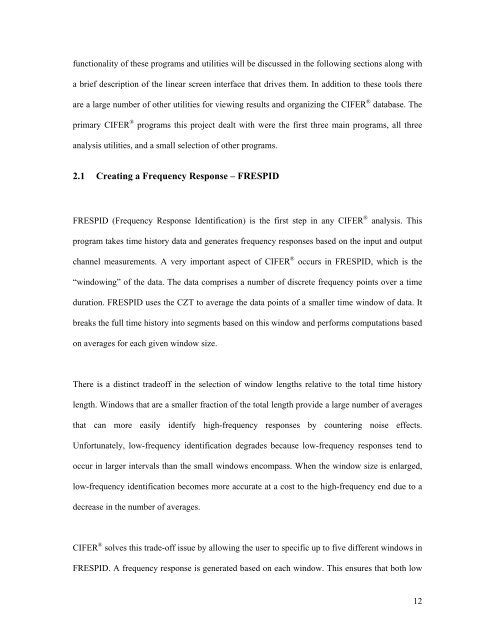CIFER®-MATLAB Interfaces: Development and ... - Cal Poly
CIFER®-MATLAB Interfaces: Development and ... - Cal Poly
CIFER®-MATLAB Interfaces: Development and ... - Cal Poly
You also want an ePaper? Increase the reach of your titles
YUMPU automatically turns print PDFs into web optimized ePapers that Google loves.
functionality of these programs <strong>and</strong> utilities will be discussed in the following sections along with<br />
a brief description of the linear screen interface that drives them. In addition to these tools there<br />
are a large number of other utilities for viewing results <strong>and</strong> organizing the CIFER ® database. The<br />
primary CIFER ® programs this project dealt with were the first three main programs, all three<br />
analysis utilities, <strong>and</strong> a small selection of other programs.<br />
2.1 Creating a Frequency Response – FRESPID<br />
FRESPID (Frequency Response Identification) is the first step in any CIFER ® analysis. This<br />
program takes time history data <strong>and</strong> generates frequency responses based on the input <strong>and</strong> output<br />
channel measurements. A very important aspect of CIFER ® occurs in FRESPID, which is the<br />
“windowing” of the data. The data comprises a number of discrete frequency points over a time<br />
duration. FRESPID uses the CZT to average the data points of a smaller time window of data. It<br />
breaks the full time history into segments based on this window <strong>and</strong> performs computations based<br />
on averages for each given window size.<br />
There is a distinct tradeoff in the selection of window lengths relative to the total time history<br />
length. Windows that are a smaller fraction of the total length provide a large number of averages<br />
that can more easily identify high-frequency responses by countering noise effects.<br />
Unfortunately, low-frequency identification degrades because low-frequency responses tend to<br />
occur in larger intervals than the small windows encompass. When the window size is enlarged,<br />
low-frequency identification becomes more accurate at a cost to the high-frequency end due to a<br />
decrease in the number of averages.<br />
CIFER ® solves this trade-off issue by allowing the user to specific up to five different windows in<br />
FRESPID. A frequency response is generated based on each window. This ensures that both low<br />
12













